The Thermic Fluid Market is set to rise from USD 4,800 Million in 2025 to USD 9,600 Million by 2035, with a yearly growth rate of 6%. More people and firms are choosing energy-saving and earth-friendly heat liquids. Also, there's growing money going into green energy and smart machines, which is a big push for the market to grow.
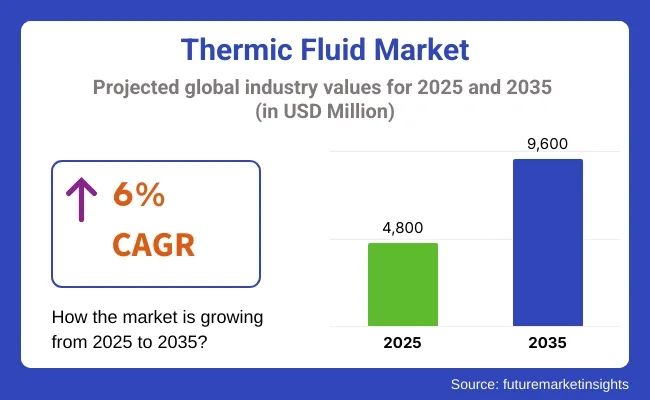
| Metric | Value |
|---|---|
| Market Size (2025E) | USD 4,800 Million |
| Market Value (2035F) | USD 9,600 Million |
| CAGR (2025 to 2035) | 6% |
The market for thermic fluids is set to grow a lot from 2025 to 2035. This is because more factories need these fluids, new tech for moving heat is coming out, and big industries like chemicals, oil and gas, and food are getting bigger. Heat fluids, known also as heat transfer liquids, are very important for keeping the right temp and saving energy in many factory jobs.
The thermic fluid market is growing fast because of the rising need for effective heat systems in factories. Mineral Oils lead the market since they are cheap, stable under heat, and used in many fields. The Chemical sector is the top user, due to its need for high heat in making petrochemicals, plastics, and special chemicals. This growth is driven by the demand for better heat handling in these industries.
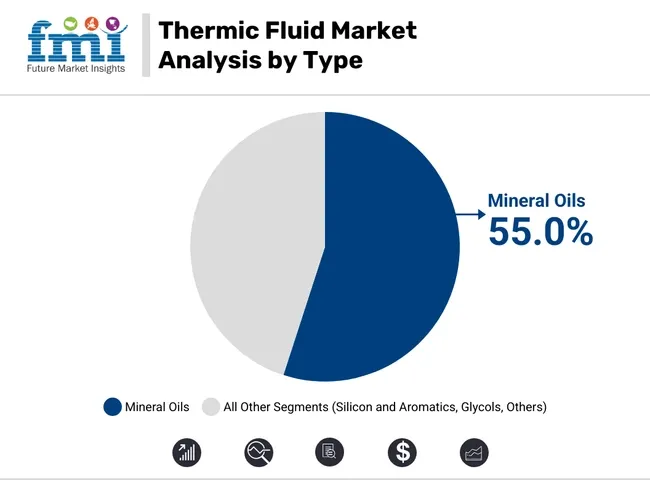
| Type | Market Share (2025) |
|---|---|
| Mineral Oils | 55.0% |
Mineral Oils Lead Market Demand Due to Affordability and Versatility
Mineral Oils have a 55% market share because they are great at moving heat, available everywhere, and cheaper to use. These oils are used a lot in chemical, food, and drug-making industries. They help keep heating systems working well and steady.
Even though new synthetic and plant-based fluids are coming out, mineral oils are still picked the most. They work well with existing setups and are cheaper. But, more rules are coming in for the environment, and there is a push toward eco-friendly options. Makers are looking into low-emission and biodegradable fluids.
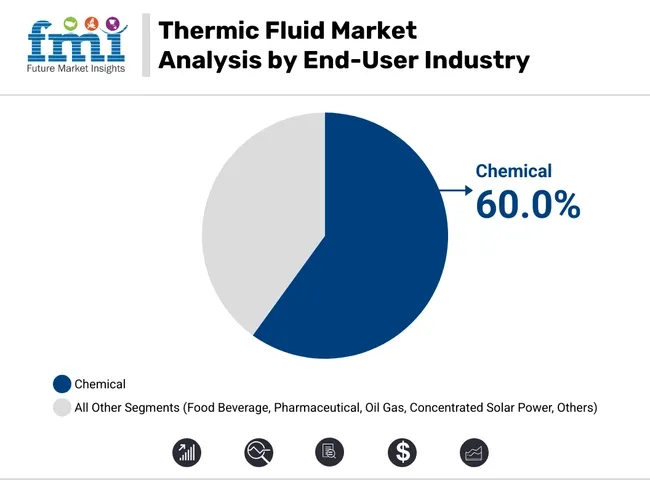
| End-User Industry | Market Share (2025) |
|---|---|
| Chemical | 60.0% |
Chemical Industry Dominates Market Adoption with High-Temperature Processing Needs
Chemicals make up 60% of the market. This is driven by more need for heat fluids in processes like distillation and reaction heating. Chemical making needs accurate temperature control. So, high-efficiency heat fluids are boosting the market growth.
Also, more production of petrochemicals, special chemicals, and new polymers helps increase the use of heat fluids. There are strict rules and a bigger push for green and energy-saving industry work. Thus, the market is shifting to eco-friendly and efficient heat fluid options.
Stringent Environmental Regulations and High Initial Costs
Thermic fluid market is highly impacted by the stringent environmental regulations regarding the utilization of few of the synthetic fluids that cause ecological threats. However, these fluids come with a high initial cost impeding its wide-spread adaptation, especially among SMEs. Periodic maintenance and fluid replacement also contribute to operational costs.
Rising Demand for Eco-Friendly and High-Performance Fluids
The rise in emphasis on sustainability and the transition towards bio-based and synthetic thermic fluids are anticipated to offer considerable growth prospects. Innovations in nanotechnology and development of high efficiency, long-lasting thermal fluids with improved heat transfer capabilities is projected to propel growth in market. Firms investing in R&D to manufacture planetary and cost-effective thermic fluids will stand out in the shifting industry paradigm.
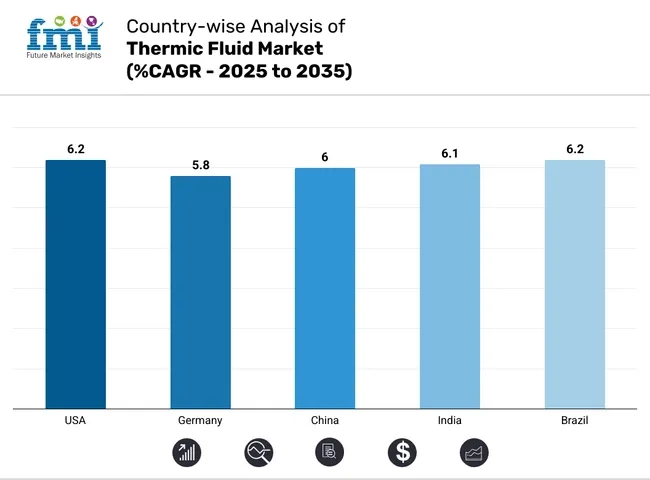
United States thermic fluid market is expected to grow due to increasing industrial functions in oil & gas, chemical processing and renewable energy sectors. Heat transfer fluids comply with environmental and workplace safety regulations from the Environmental Protection Agency (EPA) and the Occupational Safety and Health Administration (OSHA).
Some of the key trends at the market include the increasing demand for synthetic thermic fluids in concentrated solar power (CSP) plants, the growing adoption of bio-based heat transfer fluids, and rising focus on energy-efficient industrial heating solutions. This is also working as a catalyst for the growth of the market owing to technological innovation for the development of high-temperature thermal oils.
| Country | CAGR (2025 to 2035) |
|---|---|
| USA | 6.2% |
Thermic fluid market in the United Kingdom is expected to increase due to growing applications in food & beverage processing, pharmaceuticals, district heating systems, and others. To enforce safety and quality standards for heat transfer fluids are regulatory authorities such as UK Health and Safety Executive (HSE) and British Standards Institution (BSI).
The thermic fluid market has seen trends like increasing focus towards low-toxicity and biodegradable thermal fluids, growing investments in industrial waste heat recovery, and rising adoption of thermic fluids in electric vehicle battery cooling applications. Moreover, you are based on developments in nanofluid-based heat transfer systems.
| Country | CAGR (2025 to 2035) |
|---|---|
| UK | 5.8% |
With increasingly stringent EU regulations regarding energy efficiency and carbon emissions, industries have adopted eco-friendly thermal fluids, thus contributing to the growth of the thermic fluid market in the European region. Regulations are governed by the European Chemicals Agency (ECHA) and European Environment Agency (EEA) for thermic fluid formulation and safety standards.
The chemical, power generation, and food industries are the key demand generators in the market, with Germany, France, and Italy accounting for the majority of the market. The expansion of renewable energy projects, such as solar thermal power plants, is also boosting the demand for high-performance synthetic and molten salt-based heat transfer fluids.
| Region | CAGR (2025 to 2035) |
|---|---|
| European Union (EU) | 6.0% |
Thermic fluid market in Japan is growing steadily and is largely supported by unique industrial applications emerging in high-temperature, chemical, and electronics cooling. Thermic fluid safety and environmentally impact are regulated by the Ministry of Economy, Trade and Industry (METI) and the Japan Industrial Standards Committee (JISC).
Key trends include the growing adoption of thermic fluids in next-generation semiconductor fabrication, its and integration into district heating networks, and increasing investment in smart energy systems. Japan is moving towards sustainable energy whilst bio-based thermic fluids are gaining momentum.
| Country | CAGR (2025 to 2035) |
|---|---|
| Japan | 6.1% |
The thermic fluid market in South Korea is growing fast. This growth comes from more factories, bigger petrochemical plants, and a lot of money going into smart factories. Agencies like the Korea Energy Agency (KEA) and the Ministry of Trade, Industry, and Energy (MOTIE) make sure that factories are safe and save energy.
Trends in the market show more need for hot fluids in electric car batteries, more use in making and storing hydrogen, and new tech in high-heat fluids. Also, South Korea's push for green ways to make things is making eco-friendly fluids more popular.
| Country | CAGR (2025 to 2035) |
|---|---|
| South Korea | 6.2% |
The thermic fluid market is growing because more people want it for use in industry heat, energy transfer, and making things. New progress in both man-made and nature-based heat fluids help drive this growth. Strict rules for saving energy, along with more use in sun power plants, chemical plants, and food processing are also helping. Companies aim for fluids that handle high heat, resist breaking down, and are good for the Earth. The market has big chemical makers, special fluid sellers, and firms that give energy solutions.
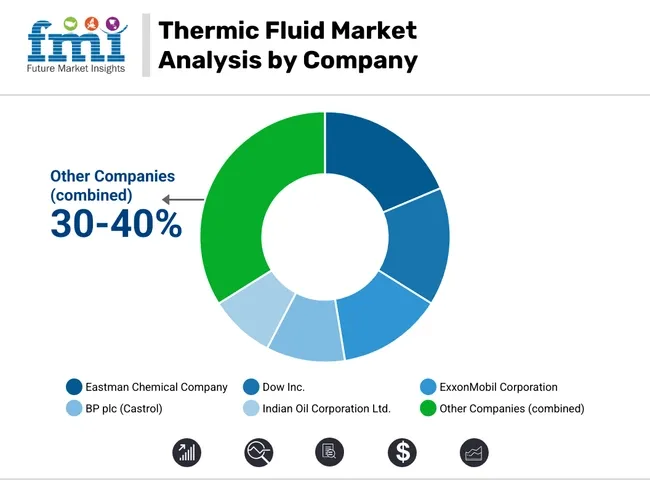
Eastman Chemical Company (18-22%)
Eastman is a leader in synthetic heat transfer fluids, providing solutions for industrial processing and energy applications.
Dow Inc. (14-18%)
Dow focuses on high-performance thermic fluids with superior oxidation resistance and extended operational life.
ExxonMobil Corporation (12-16%)
ExxonMobil specializes in premium thermic fluids designed for extreme temperature conditions and long-term stability.
BP plc (Castrol) (8-12%)
Castrol develops environmentally friendly thermic fluids for industrial and energy sectors.
Indian Oil Corporation Ltd. (6-10%)
Indian Oil provides cost-effective and high-performance thermal oils for diverse industrial applications.
Other Key Players (30-40% Combined)
Several other companies contribute to innovations in the thermic fluid market, including:
The overall market size for the thermic fluid market was USD 4,800 Million in 2025.
The thermic fluid market is expected to reach USD 9,600 Million in 2035.
Increasing demand for efficient heat transfer solutions in industrial applications, rapid expansion of the chemical and oil & gas industries, growth in renewable energy sectors such as concentrated solar power (CSP), and advancements in high-performance thermic fluids will drive market growth.
The USA, China, Germany, India, and Japan are key contributors.
The synthetic thermic fluids segment is expected to lead due to their superior thermal stability, oxidation resistance, and longer operational lifespan.
Table 1: Global Market Value (US$ Million) Forecast by Region, 2017 to 2032
Table 2: Global Market Volume (Tonnes) Forecast by Region, 2017 to 2032
Table 3: Global Market Value (US$ Million) Forecast by Application, 2017 to 2032
Table 4: Global Market Volume (Tonnes) Forecast by Application, 2017 to 2032
Table 5: Global Market Value (US$ Million) Forecast by Product Type, 2017 to 2032
Table 6: Global Market Volume (Tonnes) Forecast by Product Type, 2017 to 2032
Table 7: North America Market Value (US$ Million) Forecast by Country, 2017 to 2032
Table 8: North America Market Volume (Tonnes) Forecast by Country, 2017 to 2032
Table 9: North America Market Value (US$ Million) Forecast by Application, 2017 to 2032
Table 10: North America Market Volume (Tonnes) Forecast by Application, 2017 to 2032
Table 11: North America Market Value (US$ Million) Forecast by Product Type, 2017 to 2032
Table 12: North America Market Volume (Tonnes) Forecast by Product Type, 2017 to 2032
Table 13: Latin America Market Value (US$ Million) Forecast by Country, 2017 to 2032
Table 14: Latin America Market Volume (Tonnes) Forecast by Country, 2017 to 2032
Table 15: Latin America Market Value (US$ Million) Forecast by Application, 2017 to 2032
Table 16: Latin America Market Volume (Tonnes) Forecast by Application, 2017 to 2032
Table 17: Latin America Market Value (US$ Million) Forecast by Product Type, 2017 to 2032
Table 18: Latin America Market Volume (Tonnes) Forecast by Product Type, 2017 to 2032
Table 19: Europe Market Value (US$ Million) Forecast by Country, 2017 to 2032
Table 20: Europe Market Volume (Tonnes) Forecast by Country, 2017 to 2032
Table 21: Europe Market Value (US$ Million) Forecast by Application, 2017 to 2032
Table 22: Europe Market Volume (Tonnes) Forecast by Application, 2017 to 2032
Table 23: Europe Market Value (US$ Million) Forecast by Product Type, 2017 to 2032
Table 24: Europe Market Volume (Tonnes) Forecast by Product Type, 2017 to 2032
Table 25: East Asia Market Value (US$ Million) Forecast by Country, 2017 to 2032
Table 26: East Asia Market Volume (Tonnes) Forecast by Country, 2017 to 2032
Table 27: East Asia Market Value (US$ Million) Forecast by Application, 2017 to 2032
Table 28: East Asia Market Volume (Tonnes) Forecast by Application, 2017 to 2032
Table 29: East Asia Market Value (US$ Million) Forecast by Product Type, 2017 to 2032
Table 30: East Asia Market Volume (Tonnes) Forecast by Product Type, 2017 to 2032
Table 31: South Asia & Pacific Market Value (US$ Million) Forecast by Country, 2017 to 2032
Table 32: South Asia & Pacific Market Volume (Tonnes) Forecast by Country, 2017 to 2032
Table 33: South Asia & Pacific Market Value (US$ Million) Forecast by Application, 2017 to 2032
Table 34: South Asia & Pacific Market Volume (Tonnes) Forecast by Application, 2017 to 2032
Table 35: South Asia & Pacific Market Value (US$ Million) Forecast by Product Type, 2017 to 2032
Table 36: South Asia & Pacific Market Volume (Tonnes) Forecast by Product Type, 2017 to 2032
Table 37: MEA Market Value (US$ Million) Forecast by Country, 2017 to 2032
Table 38: MEA Market Volume (Tonnes) Forecast by Country, 2017 to 2032
Table 39: MEA Market Value (US$ Million) Forecast by Application, 2017 to 2032
Table 40: MEA Market Volume (Tonnes) Forecast by Application, 2017 to 2032
Table 41: MEA Market Value (US$ Million) Forecast by Product Type, 2017 to 2032
Table 42: MEA Market Volume (Tonnes) Forecast by Product Type, 2017 to 2032
Figure 1: Global Market Value (US$ Million) by Application, 2022 to 2032
Figure 2: Global Market Value (US$ Million) by Product Type, 2022 to 2032
Figure 3: Global Market Value (US$ Million) by Region, 2022 to 2032
Figure 4: Global Market Value (US$ Million) Analysis by Region, 2017 to 2032
Figure 5: Global Market Volume (Tonnes) Analysis by Region, 2017 to 2032
Figure 6: Global Market Value Share (%) and BPS Analysis by Region, 2022 to 2032
Figure 7: Global Market Y-o-Y Growth (%) Projections by Region, 2022 to 2032
Figure 8: Global Market Value (US$ Million) Analysis by Application, 2017 to 2032
Figure 9: Global Market Volume (Tonnes) Analysis by Application, 2017 to 2032
Figure 10: Global Market Value Share (%) and BPS Analysis by Application, 2022 to 2032
Figure 11: Global Market Y-o-Y Growth (%) Projections by Application, 2022 to 2032
Figure 12: Global Market Value (US$ Million) Analysis by Product Type, 2017 to 2032
Figure 13: Global Market Volume (Tonnes) Analysis by Product Type, 2017 to 2032
Figure 14: Global Market Value Share (%) and BPS Analysis by Product Type, 2022 to 2032
Figure 15: Global Market Y-o-Y Growth (%) Projections by Product Type, 2022 to 2032
Figure 16: Global Market Attractiveness by Application, 2022 to 2032
Figure 17: Global Market Attractiveness by Product Type, 2022 to 2032
Figure 18: Global Market Attractiveness by Region, 2022 to 2032
Figure 19: North America Market Value (US$ Million) by Application, 2022 to 2032
Figure 20: North America Market Value (US$ Million) by Product Type, 2022 to 2032
Figure 21: North America Market Value (US$ Million) by Country, 2022 to 2032
Figure 22: North America Market Value (US$ Million) Analysis by Country, 2017 to 2032
Figure 23: North America Market Volume (Tonnes) Analysis by Country, 2017 to 2032
Figure 24: North America Market Value Share (%) and BPS Analysis by Country, 2022 to 2032
Figure 25: North America Market Y-o-Y Growth (%) Projections by Country, 2022 to 2032
Figure 26: North America Market Value (US$ Million) Analysis by Application, 2017 to 2032
Figure 27: North America Market Volume (Tonnes) Analysis by Application, 2017 to 2032
Figure 28: North America Market Value Share (%) and BPS Analysis by Application, 2022 to 2032
Figure 29: North America Market Y-o-Y Growth (%) Projections by Application, 2022 to 2032
Figure 30: North America Market Value (US$ Million) Analysis by Product Type, 2017 to 2032
Figure 31: North America Market Volume (Tonnes) Analysis by Product Type, 2017 to 2032
Figure 32: North America Market Value Share (%) and BPS Analysis by Product Type, 2022 to 2032
Figure 33: North America Market Y-o-Y Growth (%) Projections by Product Type, 2022 to 2032
Figure 34: North America Market Attractiveness by Application, 2022 to 2032
Figure 35: North America Market Attractiveness by Product Type, 2022 to 2032
Figure 36: North America Market Attractiveness by Country, 2022 to 2032
Figure 37: Latin America Market Value (US$ Million) by Application, 2022 to 2032
Figure 38: Latin America Market Value (US$ Million) by Product Type, 2022 to 2032
Figure 39: Latin America Market Value (US$ Million) by Country, 2022 to 2032
Figure 40: Latin America Market Value (US$ Million) Analysis by Country, 2017 to 2032
Figure 41: Latin America Market Volume (Tonnes) Analysis by Country, 2017 to 2032
Figure 42: Latin America Market Value Share (%) and BPS Analysis by Country, 2022 to 2032
Figure 43: Latin America Market Y-o-Y Growth (%) Projections by Country, 2022 to 2032
Figure 44: Latin America Market Value (US$ Million) Analysis by Application, 2017 to 2032
Figure 45: Latin America Market Volume (Tonnes) Analysis by Application, 2017 to 2032
Figure 46: Latin America Market Value Share (%) and BPS Analysis by Application, 2022 to 2032
Figure 47: Latin America Market Y-o-Y Growth (%) Projections by Application, 2022 to 2032
Figure 48: Latin America Market Value (US$ Million) Analysis by Product Type, 2017 to 2032
Figure 49: Latin America Market Volume (Tonnes) Analysis by Product Type, 2017 to 2032
Figure 50: Latin America Market Value Share (%) and BPS Analysis by Product Type, 2022 to 2032
Figure 51: Latin America Market Y-o-Y Growth (%) Projections by Product Type, 2022 to 2032
Figure 52: Latin America Market Attractiveness by Application, 2022 to 2032
Figure 53: Latin America Market Attractiveness by Product Type, 2022 to 2032
Figure 54: Latin America Market Attractiveness by Country, 2022 to 2032
Figure 55: Europe Market Value (US$ Million) by Application, 2022 to 2032
Figure 56: Europe Market Value (US$ Million) by Product Type, 2022 to 2032
Figure 57: Europe Market Value (US$ Million) by Country, 2022 to 2032
Figure 58: Europe Market Value (US$ Million) Analysis by Country, 2017 to 2032
Figure 59: Europe Market Volume (Tonnes) Analysis by Country, 2017 to 2032
Figure 60: Europe Market Value Share (%) and BPS Analysis by Country, 2022 to 2032
Figure 61: Europe Market Y-o-Y Growth (%) Projections by Country, 2022 to 2032
Figure 62: Europe Market Value (US$ Million) Analysis by Application, 2017 to 2032
Figure 63: Europe Market Volume (Tonnes) Analysis by Application, 2017 to 2032
Figure 64: Europe Market Value Share (%) and BPS Analysis by Application, 2022 to 2032
Figure 65: Europe Market Y-o-Y Growth (%) Projections by Application, 2022 to 2032
Figure 66: Europe Market Value (US$ Million) Analysis by Product Type, 2017 to 2032
Figure 67: Europe Market Volume (Tonnes) Analysis by Product Type, 2017 to 2032
Figure 68: Europe Market Value Share (%) and BPS Analysis by Product Type, 2022 to 2032
Figure 69: Europe Market Y-o-Y Growth (%) Projections by Product Type, 2022 to 2032
Figure 70: Europe Market Attractiveness by Application, 2022 to 2032
Figure 71: Europe Market Attractiveness by Product Type, 2022 to 2032
Figure 72: Europe Market Attractiveness by Country, 2022 to 2032
Figure 73: East Asia Market Value (US$ Million) by Application, 2022 to 2032
Figure 74: East Asia Market Value (US$ Million) by Product Type, 2022 to 2032
Figure 75: East Asia Market Value (US$ Million) by Country, 2022 to 2032
Figure 76: East Asia Market Value (US$ Million) Analysis by Country, 2017 to 2032
Figure 77: East Asia Market Volume (Tonnes) Analysis by Country, 2017 to 2032
Figure 78: East Asia Market Value Share (%) and BPS Analysis by Country, 2022 to 2032
Figure 79: East Asia Market Y-o-Y Growth (%) Projections by Country, 2022 to 2032
Figure 80: East Asia Market Value (US$ Million) Analysis by Application, 2017 to 2032
Figure 81: East Asia Market Volume (Tonnes) Analysis by Application, 2017 to 2032
Figure 82: East Asia Market Value Share (%) and BPS Analysis by Application, 2022 to 2032
Figure 83: East Asia Market Y-o-Y Growth (%) Projections by Application, 2022 to 2032
Figure 84: East Asia Market Value (US$ Million) Analysis by Product Type, 2017 to 2032
Figure 85: East Asia Market Volume (Tonnes) Analysis by Product Type, 2017 to 2032
Figure 86: East Asia Market Value Share (%) and BPS Analysis by Product Type, 2022 to 2032
Figure 87: East Asia Market Y-o-Y Growth (%) Projections by Product Type, 2022 to 2032
Figure 88: East Asia Market Attractiveness by Application, 2022 to 2032
Figure 89: East Asia Market Attractiveness by Product Type, 2022 to 2032
Figure 90: East Asia Market Attractiveness by Country, 2022 to 2032
Figure 91: South Asia & Pacific Market Value (US$ Million) by Application, 2022 to 2032
Figure 92: South Asia & Pacific Market Value (US$ Million) by Product Type, 2022 to 2032
Figure 93: South Asia & Pacific Market Value (US$ Million) by Country, 2022 to 2032
Figure 94: South Asia & Pacific Market Value (US$ Million) Analysis by Country, 2017 to 2032
Figure 95: South Asia & Pacific Market Volume (Tonnes) Analysis by Country, 2017 to 2032
Figure 96: South Asia & Pacific Market Value Share (%) and BPS Analysis by Country, 2022 to 2032
Figure 97: South Asia & Pacific Market Y-o-Y Growth (%) Projections by Country, 2022 to 2032
Figure 98: South Asia & Pacific Market Value (US$ Million) Analysis by Application, 2017 to 2032
Figure 99: South Asia & Pacific Market Volume (Tonnes) Analysis by Application, 2017 to 2032
Figure 100: South Asia & Pacific Market Value Share (%) and BPS Analysis by Application, 2022 to 2032
Figure 101: South Asia & Pacific Market Y-o-Y Growth (%) Projections by Application, 2022 to 2032
Figure 102: South Asia & Pacific Market Value (US$ Million) Analysis by Product Type, 2017 to 2032
Figure 103: South Asia & Pacific Market Volume (Tonnes) Analysis by Product Type, 2017 to 2032
Figure 104: South Asia & Pacific Market Value Share (%) and BPS Analysis by Product Type, 2022 to 2032
Figure 105: South Asia & Pacific Market Y-o-Y Growth (%) Projections by Product Type, 2022 to 2032
Figure 106: South Asia & Pacific Market Attractiveness by Application, 2022 to 2032
Figure 107: South Asia & Pacific Market Attractiveness by Product Type, 2022 to 2032
Figure 108: South Asia & Pacific Market Attractiveness by Country, 2022 to 2032
Figure 109: MEA Market Value (US$ Million) by Application, 2022 to 2032
Figure 110: MEA Market Value (US$ Million) by Product Type, 2022 to 2032
Figure 111: MEA Market Value (US$ Million) by Country, 2022 to 2032
Figure 112: MEA Market Value (US$ Million) Analysis by Country, 2017 to 2032
Figure 113: MEA Market Volume (Tonnes) Analysis by Country, 2017 to 2032
Figure 114: MEA Market Value Share (%) and BPS Analysis by Country, 2022 to 2032
Figure 115: MEA Market Y-o-Y Growth (%) Projections by Country, 2022 to 2032
Figure 116: MEA Market Value (US$ Million) Analysis by Application, 2017 to 2032
Figure 117: MEA Market Volume (Tonnes) Analysis by Application, 2017 to 2032
Figure 118: MEA Market Value Share (%) and BPS Analysis by Application, 2022 to 2032
Figure 119: MEA Market Y-o-Y Growth (%) Projections by Application, 2022 to 2032
Figure 120: MEA Market Value (US$ Million) Analysis by Product Type, 2017 to 2032
Figure 121: MEA Market Volume (Tonnes) Analysis by Product Type, 2017 to 2032
Figure 122: MEA Market Value Share (%) and BPS Analysis by Product Type, 2022 to 2032
Figure 123: MEA Market Y-o-Y Growth (%) Projections by Product Type, 2022 to 2032
Figure 124: MEA Market Attractiveness by Application, 2022 to 2032
Figure 125: MEA Market Attractiveness by Product Type, 2022 to 2032
Figure 126: MEA Market Attractiveness by Country, 2022 to 2032






Full Research Suite comprises of:
Market outlook & trends analysis
Interviews & case studies
Strategic recommendations
Vendor profiles & capabilities analysis
5-year forecasts
8 regions and 60+ country-level data splits
Market segment data splits
12 months of continuous data updates
DELIVERED AS:
PDF EXCEL ONLINE
Fluidized Conveying Equipment Market Size and Share Forecast Outlook 2025 to 2035
Fluidized Bed Dryer Market Size and Share Forecast Outlook 2025 to 2035
Fluid Aspiration System Market Size and Share Forecast Outlook 2025 to 2035
Fluid Dispensing Equipment Market Size and Share Forecast Outlook 2025 to 2035
Fluid Couplings Market Analysis - Size, Growth, and Forecast 2025 to 2035
Fluid Conveyance Systems Market Growth - Trends & Forecast 2025 to 2035
Fluid Transfer Solutions Market – Demand & Forecast 2024-2034
Fluid Waste Disposal Systems Market
Fluid Bed Systems Market
Fluid Catalytic Cracking Catalysts Market
Fluid Bed and Coating System Market
IV Fluid Transfer Drugs Devices Market Trends – Growth & Forecast 2025 to 2035
Air Fluidized Therapy Beds Market Growth – Trends & Forecast 2025 to 2035
Microfluidic Modulation Spectroscopy Market Size and Share Forecast Outlook 2025 to 2035
Microfluidics Market Analysis - Technology, Trends & Forecast 2025 to 2035
I.V. Fluid Warmer Market
The Blood Fluid Warming System Market is segmented by product type, application, and end user from 2025 to 2035
Equine Fluid Therapy Market
Deicing Fluid Market Growth - Trends & Forecast 2025 to 2035
Cutting Fluid Market Growth – Trends & Forecast 2025-2035

Thank you!
You will receive an email from our Business Development Manager. Please be sure to check your SPAM/JUNK folder too.
Chat With
MaRIA